Report Example
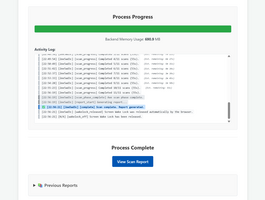
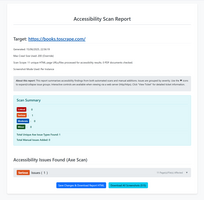
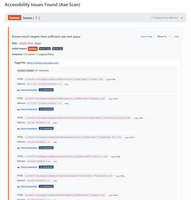
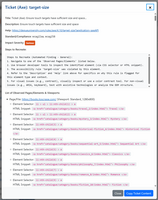
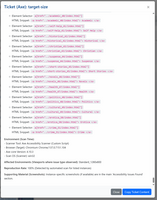
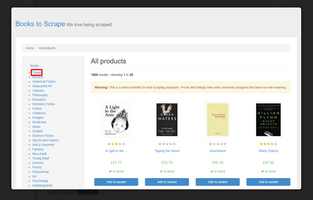
Anatomy of the Report: A Professional Overview
Each accessibility report is a comprehensive, standalone, and interactive analysis document designed for clarity and actionability. The report is structured into the following key components:
Executive Summary & Scan Parameters
The document begins with essential metadata providing context for the scan results. This section includes:
- Report Identification: A main title and the specific target URL or file path that was the subject of the scan.
- Scan Configuration & Intelligence: An overview of the parameters used, such as the execution date, defined crawl depth, and screenshot mode. This also notes which key intelligence features were active, such as Smart Crawl or the Adaptive Remediation Engine.
- Top-Level Findings: A quantitative summary of unique issue types, categorized by severity level (Critical, Serious, Moderate, and Minor). Each severity level is color-coded for immediate visual assessment, allowing stakeholders to quickly gauge the overall accessibility posture.
Scan Execution & Scope Details
This section provides transparency into the scanning process itself, detailing any limitations or errors encountered.
- Crawl & Setup Errors: An enumeration of all URLs that the scanner was unable to access due to network timeouts, HTTP errors, or other connectivity issues.
- Page Scan Errors: A list of pages that were successfully accessed but where the accessibility audit engine could not execute correctly.
- PDF Tagging Analysis: For scans configured to check PDFs, this area presents the findings, indicating whether discovered PDF documents were identified as "Tagged" or "Not Tagged."
- Skipped Pages: A detailed log of all URLs that were discovered but intentionally excluded from the scan, with explicit reasons such as exclusion by user-defined patterns, robots.txt directives, or the Smart Crawl engine identifying a potential crawler trap.
Detailed Accessibility Findings
The core of the report presents an in-depth analysis of all detected accessibility issues, organized for efficient triage and remediation.
- Severity-Based Grouping: All identified issues are grouped by their severity level. These groups are presented in collapsible sections, enabling users to focus on the most critical findings first.
- Issue Analysis: Each unique issue type is detailed with the following information:
- Violation Description: A clear, concise explanation of the accessibility issue and its impact on users.
- Remediation & Standards: The specific axe-core rule ID is provided, with a direct link to the Deque University knowledge base for comprehensive remediation guidance. Associated WCAG success criteria are also listed.
- Violation Instances: A complete record of every page, viewport, and dynamic state (if Interaction Scanning was used) where the issue was detected.
- Element-Specific Data: For each individual violation, the report provides the exact HTML source code snippet and the precise CSS selector, enabling development teams to pinpoint the element without ambiguity.
- Visual Evidence: Clicking the screenshot icon opens a modal with a full-size image of the page, where the non-compliant element is clearly highlighted, offering unambiguous visual context for the issue.
Unified Audit View
The report is designed to be a single source of truth for your entire audit, combining automated and manual findings.
- Integrated Manual Findings: Any issues added via the "Add Manual Issues" UI are seamlessly integrated into their own dedicated, collapsible section within the report. This allows auditors to present their expert findings alongside the automated results in a single, cohesive document.
Actionable Remediation Tools
Beyond just presenting data, the report includes built-in tools to accelerate the development workflow.
- Integrated Ticket Generation: For each issue, a "View Ticket" button opens a modal containing pre-formatted, copy-paste-ready content for your issue tracker (e.g., Jira, Azure DevOps, Dundie). This content includes a descriptive title, reproduction steps, code snippets, environmental details, and links to remediation resources, dramatically reducing the time it takes to create actionable development tasks.
Report Example From 4.0.2.9
💾 Download
Get 📡 Accessibility-Scanner
📡 Accessibility-Scanner
Axe Scanner 📡
| Status | In development |
| Category | Tool |
| Author | Lachie1999 💾 |
| Tags | a11y, accessibility, Automation, nodejs, software |
More posts
- Accessibility Scanner – Update Notes Version 4.0.21 day ago
- Accessibility Scanner – Update Notes Version 4.0.16 days ago
- Example Scan Configuration'sJun 04, 2025
- Tool InformationMay 10, 2025
- Accessibility Scanner: Troubleshooting GuideMay 08, 2025
- Terms & ConditionsApr 28, 2025
- System RequirementsApr 27, 2025
- Accessibility Scanner GuideApr 23, 2025